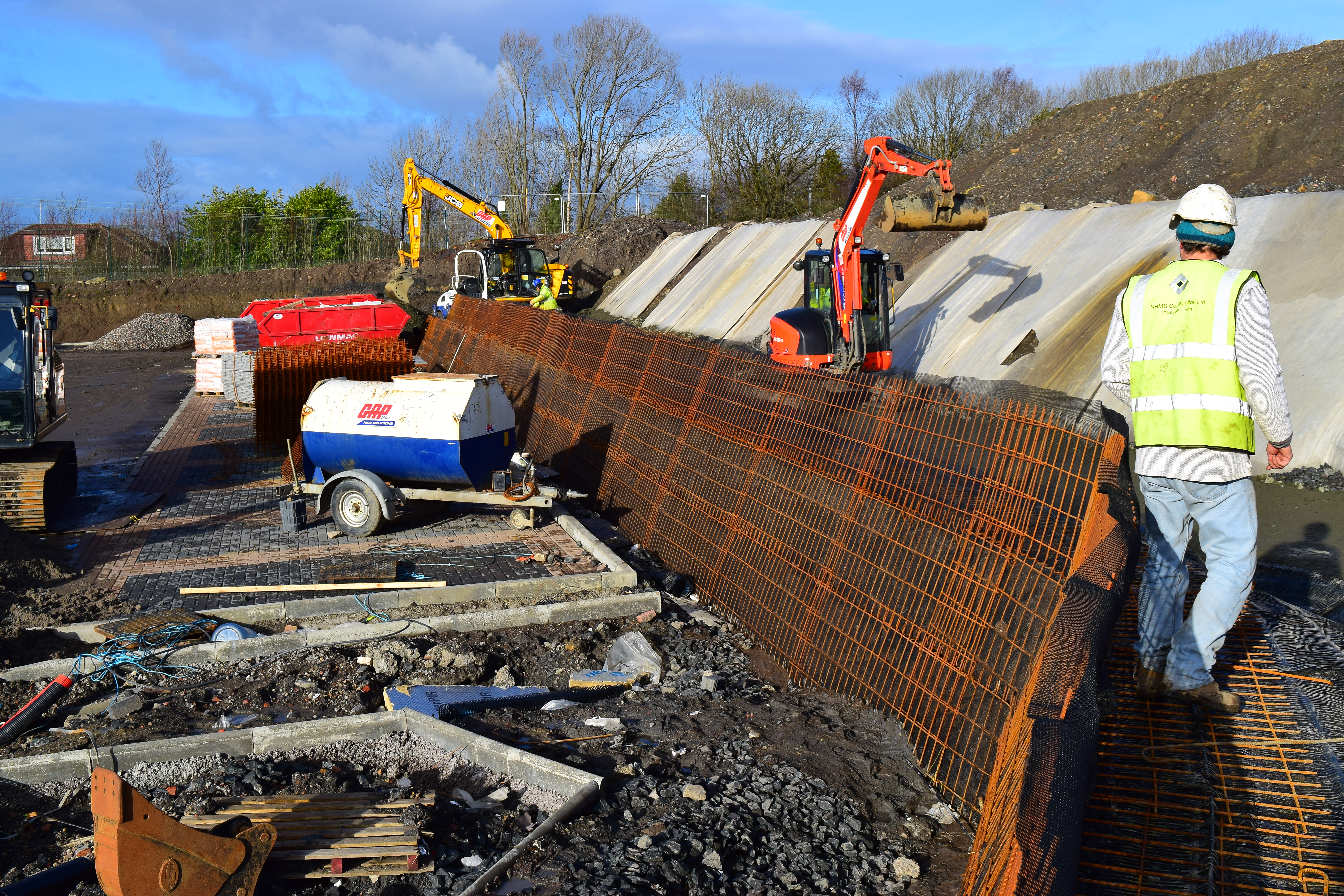Pore water pressure and the importance of drainage
by Andrew Lees, on May 14, 2020
Pore water pressure and drainage are key considerations when designing earthworks using compacted clay fill, including reinforced soil structures.
Without appropriate drainage, rainfall can saturate the clay and increase its pore water pressure. This, in turn, reduces the soil’s effective stress, results in a loss of strength and can potentially lead to failure.
This guide explains what pore water pressure is, the formula used to calculate pore pressure, and its role in determining the structural integrity of earthworks. It also outlines how effective water drainage systems help to maintain pore water pressure and effective stress, preventing structures from collapsing.
Read on to learn more about:
- What is pore water pressure?
- Factors that contribute to pore water pressure development
- Effective stress, negative pore pressure and suction
- Pore water pressure in saturated soils
- Pore water pressure formula
- Why does the water drainage system matter?
- The importance of drainage in reinforced clay fill
- Designing drainage in geosynthetic-reinforced soil slopes
- How Tensar can help
Tensar offers a range of soil retaining wall solutions to suit different budgets, design codes, and drainage requirements. Equally, our geogrids are designed to stabilise soil and aggregates whilst maintaining drainage. Speak to our team today to discover how we could help you save time and money on your next project.
What is pore water pressure?
Essentially, pore water pressure is the pressure of groundwater held between soil or rocks in the gaps (or ‘pores’) between particles. It is affected by the soil type, water flow conditions and level of the water table.
Pore pressure is important in geotechnical engineering as it influences soil behaviour, including its shear strength and bearing capacity.
Factors that contribute to pore water pressure development
Hydrostatic water pressure
Hydrostatic water pressure occurs due to the weight of the water and any soil or sediment above a given point. The deeper you go into the fluid or saturated soil, the greater the pressure transmitted through the water in the pores.
Hydrostatic water pressure can be calculated using the formula P=ρgh, where P is the hydrostatic pressure, ρ\rhoρ is the density of the fluid, g is the acceleration due to gravity, and h is the depth below the fluid surface.
Changes in the water table
Fluctuations in the water table can lead to variations in pore water pressure. When the water table rises, pore water pressure increases; when it falls, it decreases. When water moves from higher to lower elevations, it creates dynamic pressure changes, which can lead to fluctuations in pore water pressure, especially in saturated soils.
Osmotic pressure
Osmotic pressure occurs when there are different amounts of dissolved particles (like salt) in water. Water naturally moves toward areas with more particles because of attraction at the molecular level. As a result, this movement creates pressure that can affect how water behaves in soil.
Absorption pressure
Soil particles can stick together because of thin films of water around them. These water films help to bind the soil particles together through a cohesive force that influences the stability and structure of the soil.
Matric suction
Matric suction is the phenomenon that describes the difference in pressure between pore air pressure and pore water pressure. As water moves from areas of high moisture to areas of lower moisture, it influences the water retention and flow in soils. Matric suction plays a crucial role in the behaviour of unsaturated soils, affecting their strength and stability.
Effective stress, negative pore pressure, and suction
Ground movement and soil slope instability can be caused by changes in total stress and pore pressure changes, such as after rainfall when pore pressure can increase.
The difference between total stress and pore pressure is the ‘effective stress’, which controls soil behaviour, such as shear strength, compression, and deformation. Effective stress is a measure of how much load a soil can carry.
Below the water table, pore pressure is positive; at the water table, pore pressure is zero. Above the water table, soil can remain saturated due to capillary rise, with negative pore pressure (suction). As the soil becomes partially saturated, suction increases due to water molecules being attracted to soil particles and generating surface tension between them. This draws the particles together, giving the soil strength.
A good example of this is wet sand in a sandcastle. The sand will remain damp in the short term due to suction, which increases effective stress and holds the sand grains together. However, over time, as the sand dries, suction is lost, and the sandcastle will collapse. It will also collapse if more water is added, as pore pressure will increase and effective stress will reduce, causing a loss of strength.
Ground Coffee – Episode 17. Andrew is in the sand pit this week, explaining the importance of negative pore pressure in sandcastles.
Pore water pressure in saturated soil
Loose, dry sand compresses if we apply a load to its surface. However, what if we were instead working with saturated soil and the gaps between particles were filled with water, preventing compaction? In this scenario, an applied load would increase pore water pressure – and the pore water would try to flow to an area of low pressure, such as the ground surface.
If a large load is applied to saturated soil over and over, such as during an earthquake, the water doesn’t have sufficient time to flow away toward lower pressure zones between loading cycles. Pore water pressure builds and can eventually reach a point where the soil particles are forced apart. At this stage, liquefaction can occur: the strength of the soil is lost, and it starts to flow like a liquid, with potentially catastrophic consequences for any structures built on the affected ground (see Soil Liquefaction: Causes, Effects, and Solutions to discover more).
Pore water pressure formula
The formula for pore water pressure (u) is:
u=γw⋅hu = \gamma_w \cdot hu=γw⋅h
Where:
- uuu is the pore water pressure (in Pascals or kPa),
- γw\gamma_wγw is the unit weight of water (approximately 9.81 kN/m³),
- hhh is the height of the water column or the depth below the groundwater table (in meters).
To calculate pore water pressure, measure the depth below the groundwater table. Then, multiply this by the unit weight of water. This gives the pressure applied by the water in the soil pores.
Why does the water drainage system matter?
A drainage system plays a pivotal role in controlling the flow and buildup of water in soils. Efficient drainage systems ensure that surplus water is effectively evacuated, maintaining the balance of forces within the soil and reducing the risk of soil instability, which could otherwise lead to a loss of shear strength and potentially catastrophic failures like landslides or foundation collapse. Other key roles of a drainage system include:
- Reducing pore water pressure: Drainage systems promote water outflow, helping to maintain controllable levels of pore water pressure.
- Preventing soil erosion: Poor drainage can cause soil erosion around the road's base, weakening the structure and increasing the risk of structural failures or hazardous sinkholes.
- Mitigating flooding: Heavy rainfall can lead to flooding. A drainage system helps to control the flow of large volumes of water quickly and efficiently.
- Reducing foul smells and pests: Flooding can attract pests, including rodents and insects. The easiest method to address this problem and ensure the safety of everyone on the property is to regularly inspect, clean, and maintain your drainage system.
The importance of drainage systems in reinforced clay fill
It is very important to consider negative pore pressure when designing earthworks, including reinforced soil structures, especially when using well-compacted clay fill. In particular, expansive clay soils are sensitive to moisture changes, swelling when saturated and shrinking when dry. A proper drainage system is vital to prevent saturation and maintain structural integrity by managing pore pressure effectively and allowing for adequate drainage.
Pore pressure management
Clay fill compacted to a normal earthworks specification is likely to have negative pore pressure up to considerable heights. Pore pressures are only likely to become positive at the base of very high structures (more than 10m to 15m high) or at lower heights if the clay is wet and soft during placement.
Suction is typically ignored in design, which provides an additional margin against failure or poor performance of the structure. As a result, it is a good idea to maintain suction in the long term.
This means incorporating drainage to prevent the clay fill from coming into prolonged contact with free water, which would otherwise saturate it. If the clay fill were to become saturated with water, its pore water pressure would increase, reducing the effective stress and resulting in a loss of strength (potentially leading to failure).
Drainage design
Internal slope drainage must let water drain out and must not let water in. It should be designed to intercept groundwater flow and be free-draining, allowing water to drain out easily and stay ‘dry’ most of the time. There should also not be ‘daylight’ at the upper surface of the structure, preventing run-off from flowing into the fill (run-off should be handled by surface water drains to avoid ponding).
Any movement of a soil structure has the potential to disrupt, or even reverse, the fall of a drain, which could result in water flowing back in – something worth considering when specifying maintenance regimes.
Designing drainage in geosynthetic-reinforced soil slopes
Geosynthetics are used in reinforced soil slopes using clay fill, and, in some cases, reinforcement layers incorporate a geotextile drainage fabric designed to reduce excess pore water pressure.
 Eastwood Health Centre clay slope being built - Clay slope being built
Eastwood Health Centre clay slope being built - Clay slope being built
However, while this may be useful in very wet fill, in the common situation where clay is compacted to normal earthworks specification, any regularly spaced fine drainage layers could allow water to penetrate well into the fill. This could increase pore pressure, causing swelling and softening, so it’s best to avoid it.
It is far better to incorporate internal drainage behind geogrid reinforcement. This will intercept groundwater flow and, when combined with adequate surface water drains to collect run-off, can reduce the risk of slope failure.

Diagram -Reinforced earth ground water flow
How Tensar can help
Tensar can assist you with accounting for drainage and pore water pressure on your next project through specially designed wall and slope systems and geotechnical engineering software, Tensar+. With 30 years of construction knowledge, design experience, and innovative geogrid products, the TensarTech permanent and temporary retaining wall and slope systems provide several facing types and construction options to suit the structure’s end use, location, and required design life.
Our retaining wall systems include precast concrete, dry-laid modular block systems (with the option of adding architectural, masonry, or brick finishes), precast concrete panel systems, gabion and crib walls, and robust units suitable for aggressive marine environments. Our TensarTech® GreenSlope System can create vegetated slopes with angles of up to 70˚.
Contact us for any questions or enquiries.
Next steps
If you enjoyed our article about pore water pressure and the importance of drainage, you may be interested in these other guides:




.png?width=400&height=400&ext=.png)